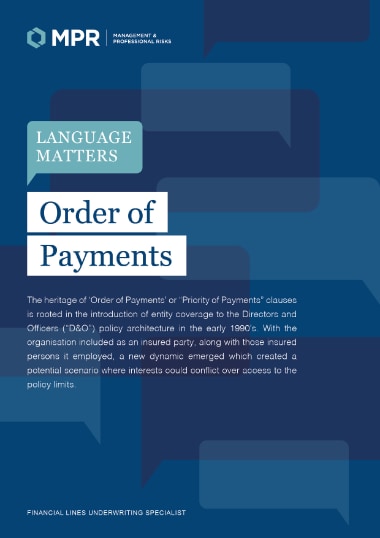The heritage of ‘Order of Payments’ or “Priority of Payments” clauses is rooted in the introduction of entity coverage to the Directors and Officers (“D&O”) policy architecture in the early 1990’s. With the organisation included as an insured party, along with those insured persons it employed, a new dynamic emerged which created a potential scenario where interests could conflict over access to the policy limits.
Generally, they provided that claims were paid for persons before organisations and established a hierarchy in favour of insured persons.
In essence, the clauses contained provisions which addressed the order in which the proceeds of the policy were to be applied if the amount of insurance available was less than the potential claim payment. Generally, they provided that claims were paid for persons before organisations and established a hierarchy in favour of insured persons through ‘priority’ of non-indemnifiable claims over indemnifiable claims. Since the origins of the D&O policy were always to first serve the directors and officers, the market developed the wordings in the direction which said that all things being equal, the policy proceeds should first go to the insured persons and if any remained, they could go to the entity. Broadly speaking, this is how they now sit in well constructed policy forms, typically titled ‘order of payments’ to more accurately reflect intentions.
…they do outline that hierarchy, and this is viewed as valuable given the uncomfortable lack of clarity if the clause is not there.
All of this sits nicely with the idea that claims costs land instantly and simultaneously for all defendant parties, but the practical reality is often different. Claims can be complicated and messy affairs, incurred over long periods for different parties in different stages, so the notion that costs can always be dispensed in apple pie order in the manner prescribed in these clauses is perhaps a little impractical and unrealistic. However, they do outline that hierarchy, and this is viewed as valuable given the uncomfortable lack of clarity if the clause is not there. Potential complications can arise when limits for insured persons are blended with those for other parties, which will almost always be the employer organisation. Any such disputes may be more challenging to navigate in the absence of any such clause because the guidance is not there. The hope is that D&O claims will be less complex and multi layered than the clause architects imagined but if they do not behave straightforwardly, the clauses most certainly have merit.


